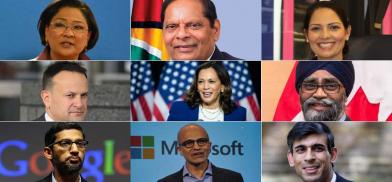The overseas Indian and the false notion of Indianness
It is simplistically assumed that no matter what, the overseas Indian considers himself/herself to be, first and foremost, Indian. When the person does not conform to such expectation, there is a sense of betrayal and of feeling let down, writes Amb Amit Dasgupta (retd) for South Asia Monitor

For sociologists, an inquiry into what constitutes the Indian identity or ‘Indianness’ is critical to the understanding of how Indians may be expected to think, act and behave. Yet, one of the great unsolved mysteries is why there are repeated misperceptions about how Indian the overseas Indian truly is. This misperception has consistently led to flawed expectations, misjudgments, and great misunderstandings.
In the realm of multiple identities that each of us navigates, certain identities are a consequence of birth, while some others are a matter of choice. Our caste or gender is a matter of birth. Foreign citizenship, on the other hand, falls in the latter category.
A sociological inquiry looks at choice when different and differing identities are placed alongside each other and cannot be accommodated simultaneously with equal commitment. This, in other words, would become the dominant identity because that determines behaviour. Certainly, the secondary identity has influence but how strong or muted that influence is on the individual and the collective remains the unsolved mystery because of the misplaced expectations others have.
The L.M Singhvi report, which was the first detailed study of the rapidly growing Indian diaspora globally, argued that the Indian diaspora was growing rapidly across the globe and was also exercising influence in local communities, including political. Consequently, understanding and interpreting how reliable and supportive the overseas Indians truly are when it comes to matters Indian and where India’s national interests may be strategically affected is a legitimate foreign policy objective.
The core assumption of the report, however, is that overseas Indians continue to be proud of their roots and hence, their Indianness. I believe this to be a deeply flawed perception.
Diaspora as a key influencer
The report is certainly correct in flagging the extraordinary potential of the diaspora being leveraged as an asset that has long been ignored. This is an appealing recommendation and swiftly gained ground. Annual sammelans (conferences) and awards were instituted to honour the diaspora. Official dispatches and public speeches referred to them as the ‘genuine ambassadors of India.’ Embassies and High Commissions were tasked to work closely with the diaspora to promote India and bilateral relations, and also to identify key influencers in the community. There was certainly merit in this, as several members of the diaspora richly deserved the accolades they were received.
Some overseas Indians became heads of state or formed government. Kamala Harris dramatically rose to become the US vice president. Many became elected officials in parliament. A few were recipients of the Nobel Prize. Several were highly qualified and respected professionals in diverse fields, ranging from law to medicine, engineering to academia, for instance. Large numbers were self-employed and entrepreneurs. They generated income and employment and thereby, contributed to the GDP of their adopted home. More importantly, members of the diaspora enjoy the respect and affection of the local community they are part of.
The role played by Indian Americans during the historic US-India 123 Agreement negotiations remains an extraordinary example of the support that was publicly acknowledged by the then US president and Indian prime minister. The observation of the Singhvi report that the diaspora is a key influencer and needs to be nurtured is, therefore, accurate.
Not a homogenous entity
The unquestioning embrace and implementation of the Singhvi report have led to the erroneous assumption that overseas Indians are a homogenous entity and that Indianness is their dominant and preferred identity. This triggered the naïve misperception that the diaspora thinks, acts, and behaves in a uniform and predictable manner, which would always be mindful and supportive of India’s strategic interests. Based on this kind of over-simplified and flawed view, unfairly exaggerated expectations have been made of the diaspora. This inability to understand, recognize and accept that the diaspora is not a homogenous entity remains one of the strangest unsolved puzzles.
There are multiple reasons behind the possible diverse reaction that overseas Indians might have on how deep their perceptions are of Indianness and consequently, of where they stand in relation to this. The generational impact is a powerful one, for instance. It would be fair to assume that the majority of first-generation Indian migrants think and behave quite differently from their children and by the time the third generation comes along, the remaining residue of Indianness has all but withered away.
Even among the first generation, those in professional jobs adapt quickly to their surroundings and adopt ways of seeing and behaving that make them conform. They recognize that in order to gain social acceptance, they need to blend in and not to be seen as the outsider. If they maintain certain cultural practices, it is more symbolic and nuanced than a deep and abiding immersion in the culture they have now left behind in a distant land that they once called ‘home.’
Second, there is an occupational impact. The educated elite and professional in private or public sector employment is able to shake off Indianness pretty quickly, as part of the need to be socially accepted. The 'tilak' on the forehead is wiped off before going for a job interview and no woman works in a corporate office dressed in a saree or salwar kameez. Several change their name from ‘Mandeep’ to ‘Mandy,’ for instance. Some Sikhs trim their beard, cut their hair, and discard their turban.
Need for assimilation
This is solely driven by the basic human instinct to survive and assimilate in an alien culture and people with whose lot they now hope to craft their future and that of their family. They choose this as their dominant culture and the one they preferentially subscribe to over the other. Indianness, then, becomes the secondary and significantly muted influence.
This might not be the case with those who live in Indian neighbourhoods and run corner stores, for instance. There is deeper adherence to Indianness because the daily interaction is with members from the Indian community, who also subscribe to similar ways of seeing and behaving. The practice of customs and rituals creates strong social bonds and community cohesion. This is, then, integrated into the second generation as part of the socialization process. Whether it would continue to survive depends on how deeply involved future generations are with the customs and practices.
Several other considerations distinguish the diaspora. For instance, not only can there be a difference within a country but also between countries. To assume that the diaspora in Fiji or South Africa is the same as the one in the UK or North America would again be an error. There are also small and opportunistic communities of anti-India members of the diaspora, who maintain their political asylum status in countries like the US, Canada, the UK, Germany, and Australia, for instance, through annual ritual protests against India and, naturally, behave quite differently from other members of the Indian diaspora.
It is, consequently, erroneous to assume that the Indian diaspora is a single and predictable entity. The heterogeneous character of the diaspora makes it imperative that engagement is a constant shifting of the frame of reference that respects choices they make with regard to their dominant identity.
The harsh, though incontrovertible, fact is that the diaspora is not Indian citizens by choice. They chose an alternative identity and proudly say that they are US or Canadian citizens, for instance. It is important to recognize and respect this reality. When Alberto Fujimori became Prime Minister of Peru, his allegiance was to Peru and to Peruvians and not to his distant Japanese descent. This would be the same with Kamala Harris and other elected representatives of Indian origin. The fallacy is to confuse the acknowledging Indianness as being the same as allegiance to India. The choice of a different nationality thrusts an alternative identity that surpasses the previous identity. Being Indian is then replaced by becoming American, for instance.
The diaspora's diversity
Unfortunately, it is simplistically assumed that no matter what, the overseas Indian considers himself/herself to be, first and foremost, Indian. When the person does not conform to such expectation, there is a sense of betrayal and of feeling let down. The perception becomes judgmental. A simple example is an acerbic reaction to the views of Indian origin Senators, for instance, who might be critical of New Delhi’s policies. It upsets us because that is not how we expect them to behave.
Such reactions are entirely a reflection of the false notion of Indianness that has imposed on the overseas Indian. Consequently, it results in misunderstandings and conflict.
To engage, nurture and leverage the Indian diaspora requires a shift from the present perception paradigm to one that recognizes the diverse character of the diaspora and respects the complex identify matrix it needs to navigate and make choices.
It is equally important to recognize that identity is not a dilemma for overseas Indians for they have made their choice. The inability to recognize and respect this, unfortunately, is the resolved mystery.
(The writer, a former Indian diplomat, is a Distinguished Fellow Australia India Institute. The views are personal)














Post a Comment